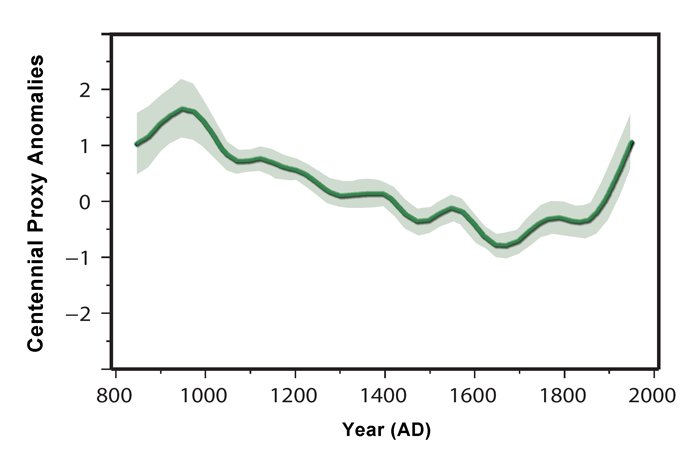Reference
Ljungqvist, F.C., Krusic, P.J., Brattstrom, G. and Sundqvist, H.S. 2012. Northern Hemisphere temperature patterns in the last 12 centuries. Climate of the Past 8: 227-249.
Background
The authors write that "a number of Northern Hemispheric (NH) temperature reconstructions covering the last 1-2 millennia, using temperature-sensitive proxy data, have been made to place the observed 20th century warming into a long-term perspective." And they say that "these studies generally agree on the occurrence of warmer conditions ca. 800-1300 AD and colder conditions ca. 1300-1900 AD, followed by a strong warming trend in the 20th century," noting that "the earlier warm period is usually referred to as the Medieval Warm Period ... whereas the later colder period is usually referred to as the Little Ice Age)." In addition, and "related to this issue," as they continue, "is the question of whether or not the current warmth has exceeded the level and geographic extent of the warmth in the last millennium," i.e., that of the Medieval Warm Period.
What was done
As Ljungqvist et al. describe it, they developed "a new reconstruction of the spatio-temporal patterns of centennial temperature variability over the NH land areas for the last twelve centuries based on 120 proxy records," which were "retrieved from a wide range of archives including, but not limited to, ice-cores, pollen, marine sediments, lake sediments, tree-rings, speleothems and historical documentary data." And with respect to how big an improvement their data base makes compared to prior studies of this type, in terms of the amount and distribution of data employed, they present a list of antecedent analyses where the number of proxy records used ranged from only 3 to 46 (compared to their 120), and where the number of records with annual resolution ranged from only 3 to 30, whereas their study included 49 such annual-resolution records.
What was learned
The final grand conglomerate result of Ljungqvist et al.'s work is depicted in the figure below.

Figure 1. Mean whole-year centennial temperature proxy anomalies (standard deviations from the AD 1000-1899 mean) vs. year AD. Shaded area represents ± 2 standard errors. Adapted from Ljungqvist et al. (2012).
As can be seen from this figure, and with respect to the climatological community's burning question of "whether or not the current warmth has exceeded the level and geographic extent of the warmth in the last millennium," the four Swedish scientists report that "during the 9th to 11th centuries there was widespread NH warmth comparable in both geographic extent and level to that of the 20th century," hopefully setting this question to rest once and for all. They do note, however, that their results indicate that "the rate of warming from the 19th to the 20th century is clearly the largest between any two consecutive centuries in the past 1200 years." But such should not be surprising, in light of the fact that the Little Ice Age is universally recognized as having been the coldest multi-century period of the current interglacial (Barclay et al., 2009; Briner et al., 2009; Menounos et al., 2009), as well as its most extensively glaciated period (Calkin et al., 2001; Clague et al., 2004; Joerin et al., 2006). And, therefore, recovery from such an extremely cold condition, once begun, would be expected to be quite dramatic.
What it means
As we have often remarked after reviewing the results of literally hundreds of paleo-temperature reconstructions stretching back over a millennium or more, there is nothing unusual, unnatural or unprecedented about earth's current level of warmth when compared to that of the Medieval Warm Period, when there was way less CO2 in the air than there is currently (~280 ppm then vs. ~395 ppm now). And this fact suggests that there is no compelling reason to necessarily attribute any of the post-Little Ice Age warming to this miniscule trace gas of the atmosphere.
References
Barclay, D.J., Wiles, G.C. and Calkin, P.E. 2009. Holocene glacier fluctuations in Alaska. Quaternary Science Reviews 28: 2034-2048.
Briner, J.P., Davis, P.T. and Miller, G.H. 2009. Latest Pleistocene and Holocene glaciation of Baffin Island, Arctic Canada: key patterns and chronologies. Quaternary Science Reviews 28: 2075-2087.
Calkin, P.E., Wiles, G.C. and Barclay, D.J. 2001. Holocene coastal glaciation of Alaska. Quaternary Science Reviews 20: 449-461.
Clague, J.J., Wohlfarth, B., Ayotte, J., Eriksson, M., Hutchinson, I., Mathewes, R.W., Walker, I.R. and Walker, L. 2004. Late Holocene environmental change at treeline in the northern Coast Mountains, British Columbia, Canada. Quaternary Science Reviews 23: 2413-2431.
Joerin, U.E., Stocker, T.F. and Schluchter, C. 2006. Multicentury glacier fluctuations in the Swiss Alps during the Holocene. The Holocene 16: 697-704.
Menounos, B., Osborn, G., Clague, J.J. and Luckman, B.H. 2009. Latest Pleistocene and Holocene glacier fluctuations in western Canada. Quaternary Science Reviews 28: 2049-2074.
Reviewed 11 July 2012



